#black people in historical costume
Text
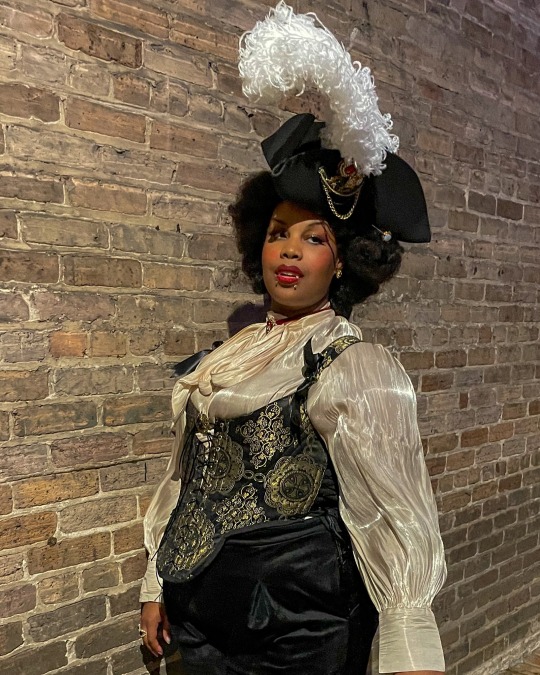

baroque gentle lady | IG
#I’m wearing vampire teeth that’s not popcorn I swear#baroque aesthetic#antique aesthetic#black people in historical costume#historical costuming#georgian era#marie antoinette#gold#dandy aesthetic#dandy#fancy dress#mignonne#2023#vampire aesthetic#black
3K notes
·
View notes
Text


a New Woman at the turn of the century. || IG
#victorian aesthetic#late victorian#1890s fashion#1890s#historical costume#black people in historical costume#black people in period clothing#edwardian#mignonne#2023
1K notes
·
View notes
Photo
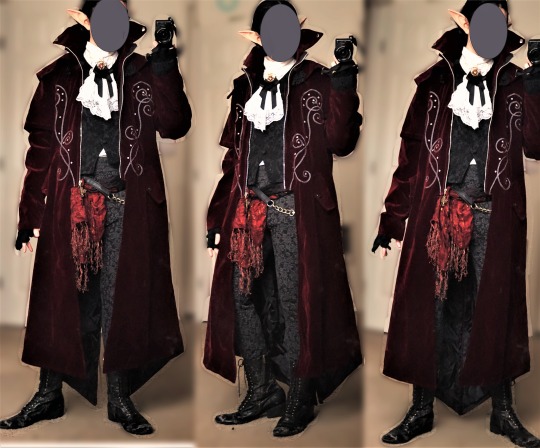
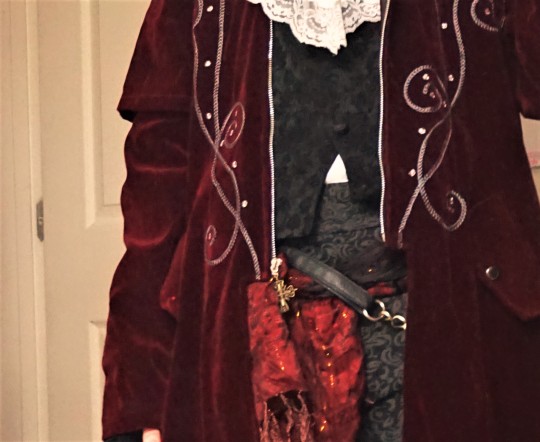
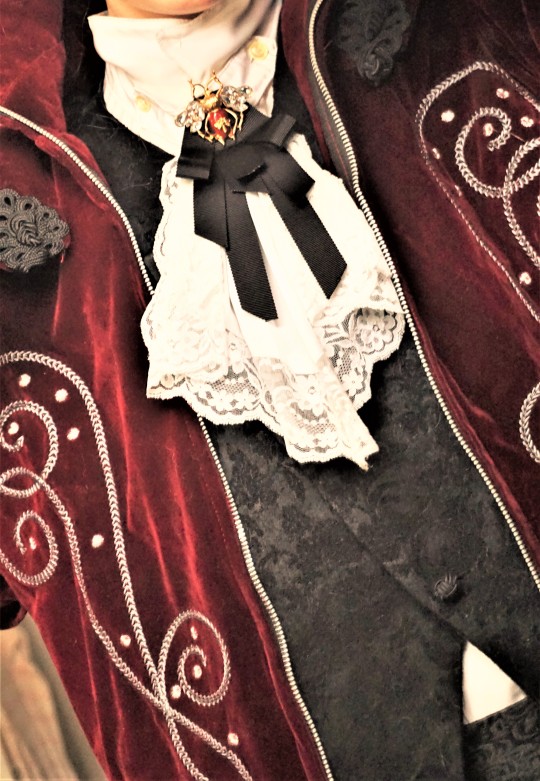
Obligatory fancier outfit that must be present anytime I post outfits
#self#fantasy costume#If I had the money for a custom tailored fantasy-ish victorian-ish suit instead of piecing together random thrift store items with like walm#rt halloween costume type jackets and stuff..#unstoppable.....#I would actually lean more straight up historical with my wardrobe it's just that everything I own basically is thrifted aside from a very#small portion of things (like usually socks for example I get from ebay. wigs from ebay. things that it's hard to find in thrift stores. etc#) and I rarely ever find stuff like that at the bins. Your closest bet is like. hopeing that the week you come in just so happens to also be#a week that a church costume department recently donated a bunch of old stuff. but I just haven't really had much luck finding like fancy ve#sts and suit coats and cloaks or like tunics and etc. etc.#Styles like mori kei or cult party kei are pretty accessible and easy for places like the bins (where youre usually digging through piles of#curtains and fabric scraps and doilies anyway). but finding like.. a straight up tudor england costume or something is . VERY rare#Sometimes you do find halloween costumes. Or like. stuff that's clearly like cheap 'Goth' stuff from shein or aliexpress that someone has do#nated and they can be a LITTLE okay in terms of usable for costumes. But you rarely find actual good quality stuff. obviously because like#real very good quality historical costumes are expensive and most people aren't just like 'yeah dump it off to goodwill' lol#In an ideal world though I would have fancy top hats and neck ruffles and stuff .. know this ghhjbhj#Lack of that will not stop me from taking picturesin basically the same outfit 6000 times though. My one single silky black vest and#one of the two solitary ruffly neck shirts I have every been able to find.#Pointy-ish little boots that I put with everything even thogugh they look terrible up close because they're literally like over 10 yrs old#I bought them so long ago and the black fake leather lining is like peeling off of the outside#ANYWAY#he's back again... the same little generic like elf vampire ruffle shirt with vest look.. might as well be the same guy#I support him and his dumbass disintegrating shoes anyway
67 notes
·
View notes
Text
trying to make a post that directly compares mary i and stannis baratheon but the problem with their parallels is that there are goddamn many and i only have TEN image slots to work with
#also becoming elizabeth really must've took some inspiration from game of thrones and how it wrote the baratheon brothers#because they REALLY turned elizabeth into renly which is...interesting#and be!mary REALLY goes with show!stannis#especially her costumes being mostly black/solemn#even funnier with their show versions being written with...questionable interactions with fire#(mary talking about burning people AND ALL OF ENGLAND years before her reign and stannis burning HIS ONLY HEIR!!!#historical!mary and book!stannis still share a lot of parallels but it leaves out a lot of mary's personality and sociability#i'm not sure who else she would parallel with from asoiaf#i'd love to know who ppl see parallels between when it comes to tudor figures and asoiaf characters#mary and stannis are the ones that jump at me most
6 notes
·
View notes
Text
So I accidentally almost got into an argument on Twitter, and now I'm thinking about bad historical costuming tropes. Specifically, Action Hero Leather Pants.
See, I was light-heartedly pointing out the inaccuracies of the costumes in Black Sails, and someone came out of the woodwork to defend the show. The misunderstanding was that they thought I was dismissing the show just for its costumes, which I wasn't - I was simply pointing out that it can't entirely care about material history (meaning specifically physical objects/culture) if it treats its clothes like that.
But this person was slightly offended on behalf of their show - especially, quote, "And from a fan of OFMD, no less!" Which got me thinking - it's true! I can abide a lot more historical costuming inaccuracy from Our Flag than I can Black Sails or Vikings. And I don't think it's just because one has my blorbos in it. But really, when it comes down to it...
What is the difference between this and this?
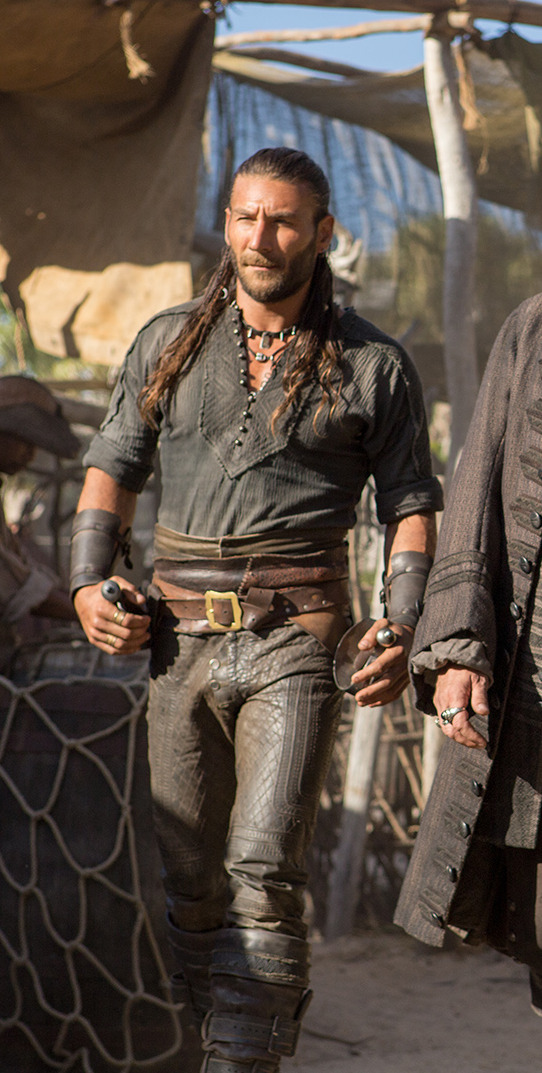
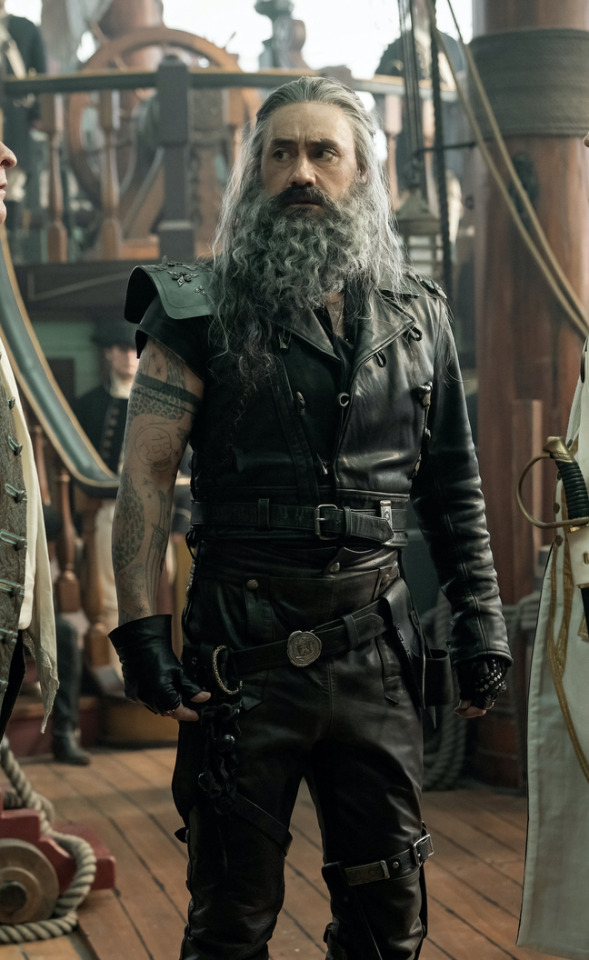
Here's the thing. Leather pants in period dramas isn't new. You've got your Vikings, Tudors, Outlander, Pirates of the Caribbean, Once Upon a Time, Will, The Musketeers, even Shakespeare in Love - they love to shove people in leather and call it a day. But where does this come from?

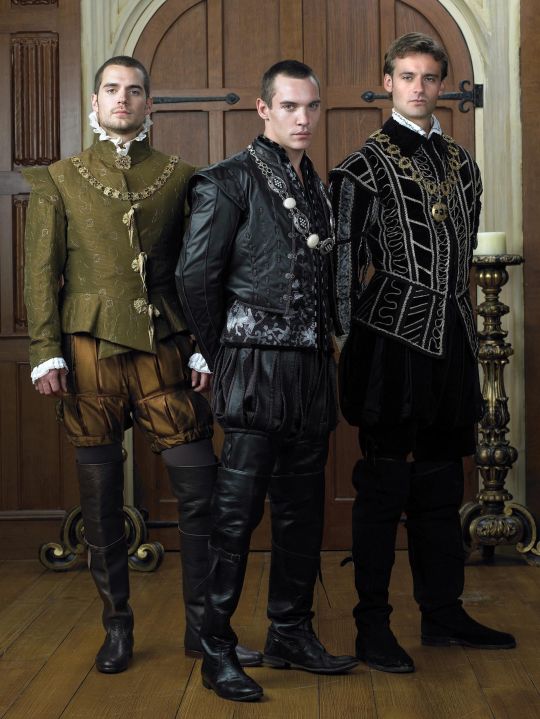
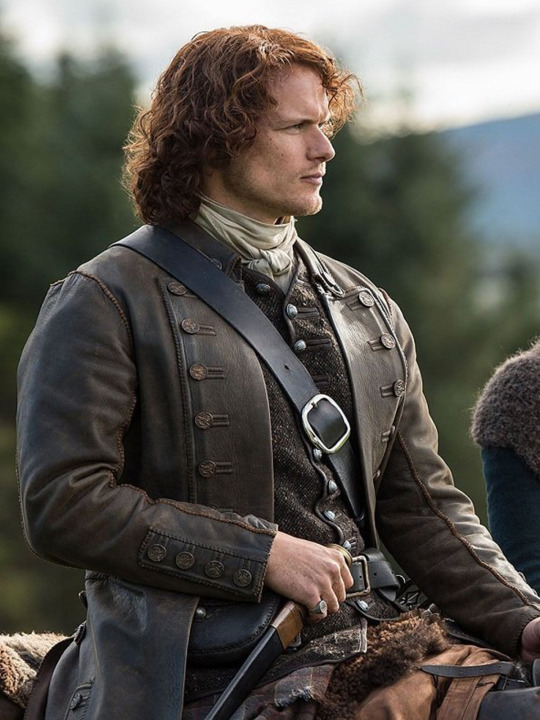

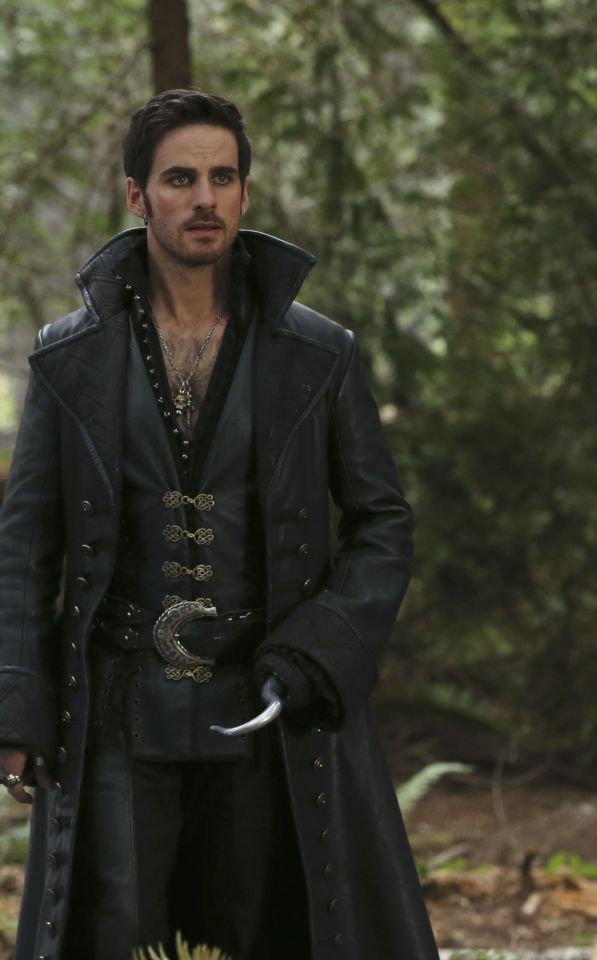
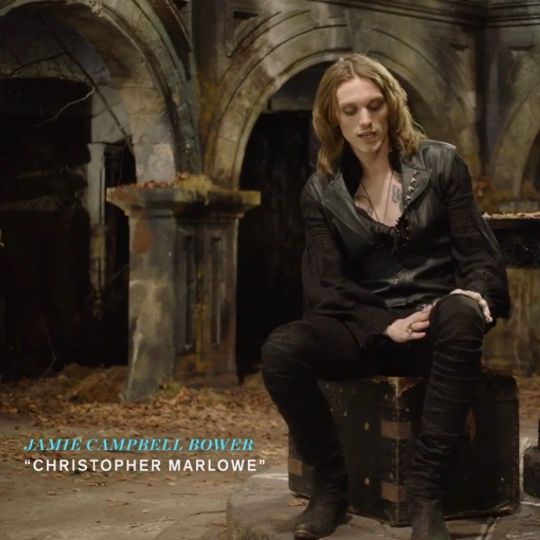
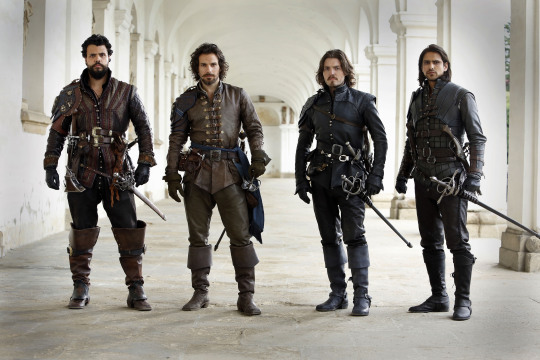

Obviously we have the modern connotations. Modern leather clothes developed in a few subcultures: cowboys drew on Native American clothing. (Allegedly. This is a little beyond my purview, I haven't seen any solid evidence, and it sounds like the kind of fact that people repeat a lot but is based on an assumption. I wouldn't know, though.) Leather was used in some WWI and II uniforms.
But the big boom came in the mid-C20th in motorcycle, punk/goth, and gay subcultures, all intertwined with each other and the above. Motorcyclists wear leather as practical protective gear, and it gets picked up by rock and punk artists as a symbol of counterculture, and transferred to movie designs. It gets wrapped up in gay and kink communities, with even more countercultural and taboo meanings. By the late C20th, leather has entered mainstream fashion, but it still carries those references to goths, punks, BDSM, and motorbike gangs, to James Dean, Marlon Brando, and Mick Jagger. This is whence we get our Spikes and Dave Listers in 1980s/90s media, bad boys and working-class punks.


And some of the above "historical" design choices clearly build on these meanings. William Shakespeare is dressed in a black leather doublet to evoke the swaggering bad boy artist heartthrob, probably down on his luck. So is Kit Marlowe.
But the associations get a little fuzzier after that. Hook, with his eyeliner and jewellery, sure. King Henry, yeah, I see it. It's hideously ahistorical, but sure. But what about Jamie and Will and Ragnar, in their browns and shabby, battle-ready chic? Well, here we get the other strain of Bad Period Drama Leather.
See, designers like to point to history, but it's just not true. Leather armour, especially in the western/European world, is very, very rare, and not just because it decays faster than metal. (Yes, even in ancient Greece/Rome, despite many articles claiming that as the start of the leather armour trend!) It simply wasn't used a lot, because it's frankly useless at defending the body compared to metal. Leather was used as a backing for some splint armour pieces, and for belts, sheathes, and buckles, but it simply wasn't worn like the costumes above. It's heavy, uncomfortable, and hard to repair - it's simply not practical for a garment when you have perfectly comfortable, insulating, and widely available linen, wool, and cotton!
As far as I can see, the real influence on leather in period dramas is fantasy. Fantasy media has proliferated the idea of leather armour as the lightweight choice for rangers, elves, and rogues, a natural, quiet, flexible material, less flashy or restrictive than metal. And it is cheaper for a costume department to make, and easier for an actor to wear on set. It's in Dungeons and Dragons and Lord of the Rings, King Arthur, Runescape, and World of Warcraft.

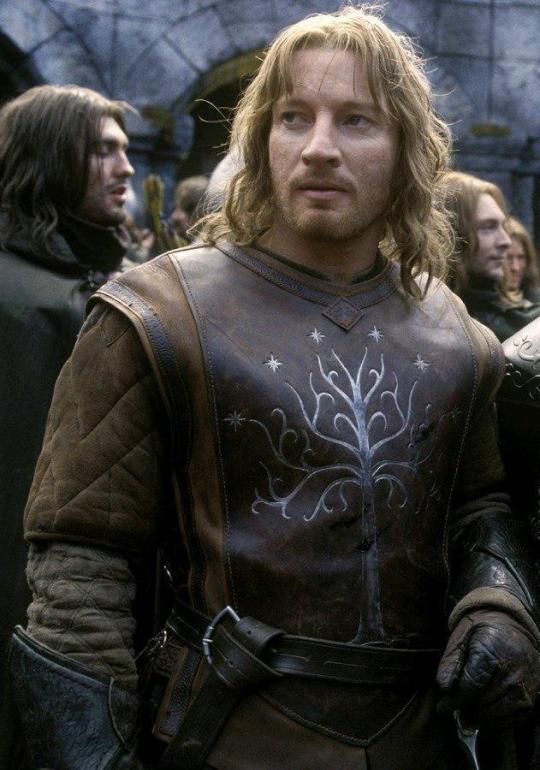
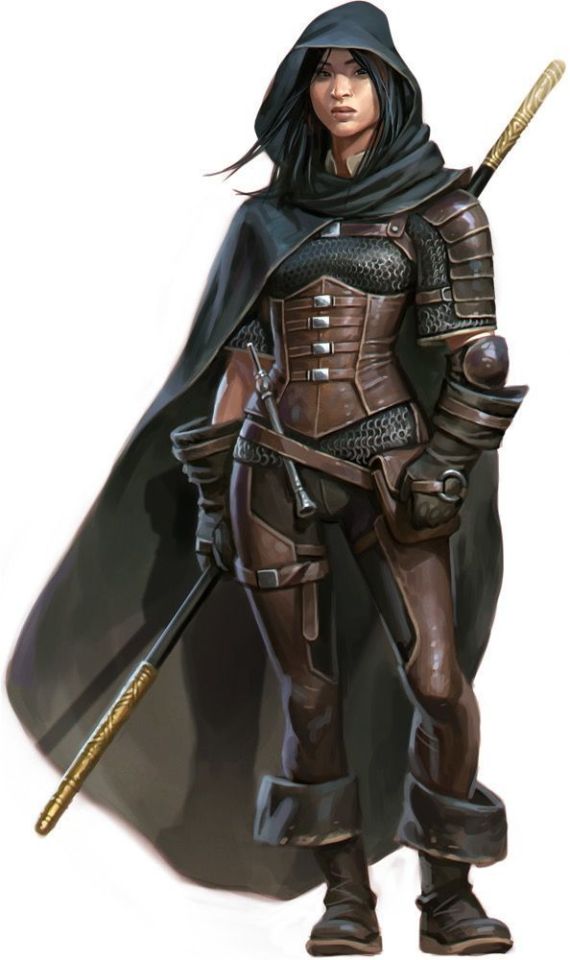
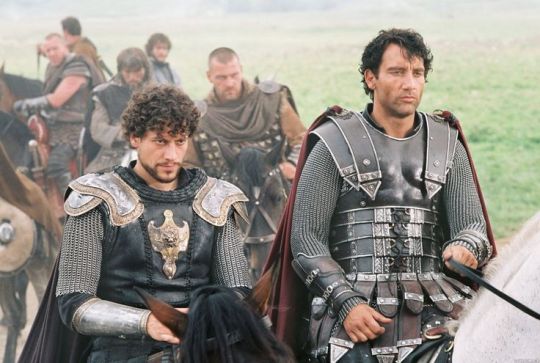

And I think this is how we get to characters like Ragnar and Vane. This idea of leather as practical gear and light armour, it's fantasy, but it has this lineage, behind which sits cowboy chaps and bomber/flight jackets. It's usually brown compared to the punk bad boy's black, less shiny, and more often piecemeal or decorated. In fact, there's a great distinction between the two Period Leather Modes within the same piece of media: Robin Hood (2006)! Compare the brooding, fascist-coded villain Guy of Gisborne with the shabby, bow-wielding, forest-dwelling Robin:

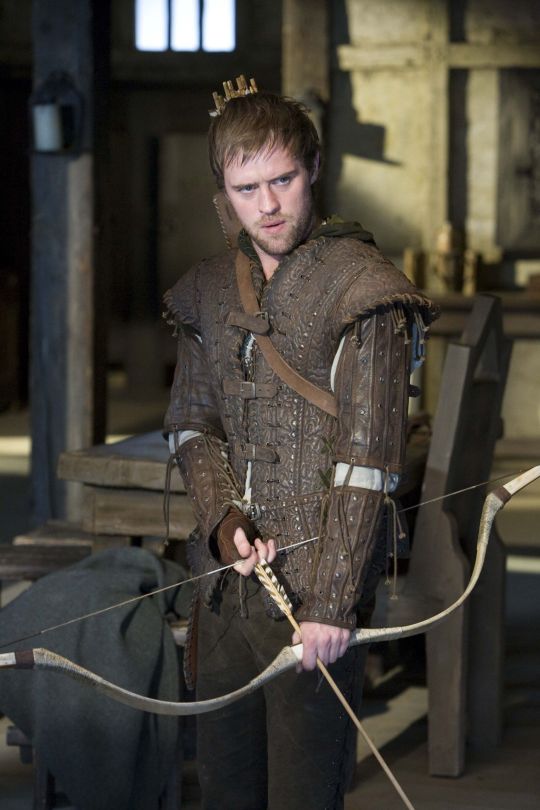
So, back to the original question: What's the difference between Charles Vane in Black Sails, and Edward Teach in Our Flag Means Death?
Simply put, it's intention. There is nothing intentional about Vane's leather in Black Sails. It's not the only leather in the show, and it only says what all shabby period leather says, relying on the same tropes as fantasy armour: he's a bad boy and a fighter in workaday leather, poor, flexible, and practical. None of these connotations are based in reality or history, and they've been done countless times before. It's boring design, neither historically accurate nor particularly creative, but much the same as all the other shabby chic fighters on our screens. He has a broad lineage in Lord of the Rings and Pirates of the Caribbean and such, but that's it.
In Our Flag, however, the lineage is much, much more intentional. Ed is a direct homage to Mad Max, the costuming in which is both practical (Max is an ex-cop and road warrior), and draws on punk and kink designs to evoke a counterculture gone mad to the point of social breakdown, exploiting the thrill of the taboo to frighten and titillate the audience.
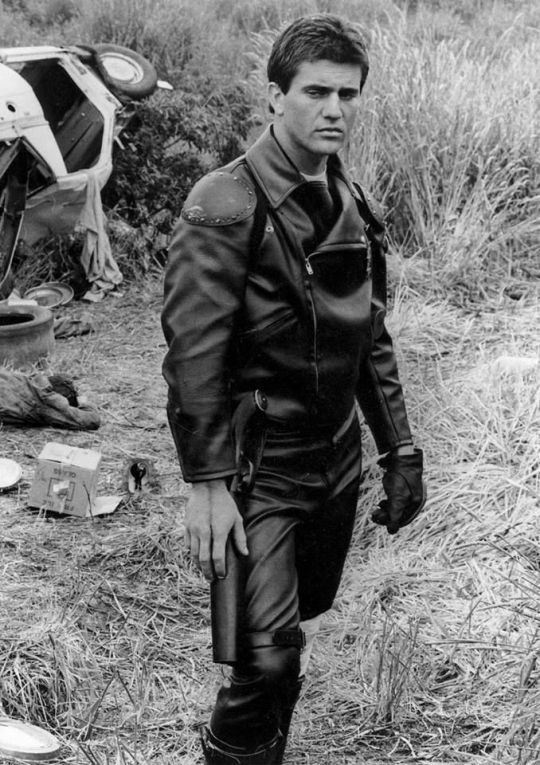
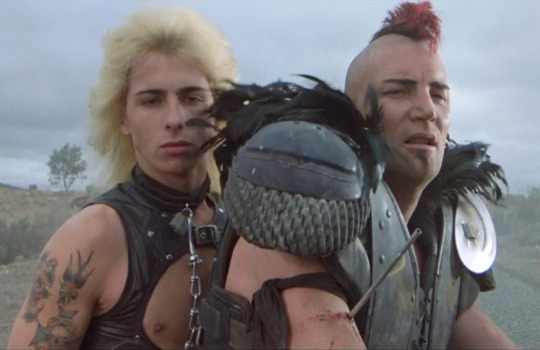
In particular, Ed is styled after Max in the second movie, having lost his family, been badly injured, and watched the world turn into an apocalypse. He's a broken man, withdrawn, violent, and deliberately cutting himself off from others to avoid getting hurt again. The plot of Mad Max 2 is him learning to open up and help others, making himself vulnerable to more loss, but more human in the process.

This ties directly into the themes of Our Flag - it's a deliberate intertext. Ed's emotional journey is also one from isolation and pain to vulnerability, community, and love. Mad Max (intentionally and unintentionally) explores themes of masculinity, violence, and power, while Max has become simplified in the popular imagination as a stoic, badass action hero rather than the more complex character he is, struggling with loss and humanity. Similarly, Our Flag explores masculinity, both textually (Stede is trying to build a less abusive pirate culture) and metatextually (the show champions complex, banal, and tender masculinities, especially when we're used to only seeing pirates in either gritty action movies or childish comedies).
Our Flag also draws on the specific countercultures of motorcycles, rockers, and gay/BDSM culture in its design and themes. Naturally, in such a queer show, one can't help but make the connection between leather pirates and leather daddies, and the design certainly nods at this, with its vests and studs. I always think about this guy, with his flat cap so reminiscient of gay leather fashions.

More overtly, though, Blackbeard and his crew are styled as both violent gangsters and countercultural rockstars. They rove the seas like a bikie gang, free and violent, and are seen as icons, bad boys and celebrities. Other pirates revere Blackbeard and wish they could be on his crew, while civilians are awed by his reputation, desperate for juicy, gory details.
This isn't all of why I like the costuming in Our Flag Means Death (especially season 1). Stede's outfits are by no means accurate, but they're a lot more accurate than most pirate media, and they're bright and colourful, with accurate and delightful silks, lace, velvets, and brocades, and lovely, puffy skirts on his jackets. Many of the Revenge crew wear recognisable sailor's trousers, and practical but bright, varied gear that easily conveys personality and flair. There is a surprising dedication to little details, like changing Ed's trousers to fall-fronts for a historical feel, Izzy's puffy sleeves, the handmade fringe on Lucius's red jacket, or the increasing absurdity of navy uniform cuffs between Nigel and Chauncey.
A really big one is the fact that they don't shy away from historical footwear! In almost every example above, we see the period drama's obsession with putting men in skinny jeans and bucket-top boots, but not only does Stede wear his little red-heeled shoes with stockings, but most of his crew, and the ordinary people of Barbados, wear low boots or pumps, and even rough, masculine characters like Pete wear knee breeches and bright colours. It's inaccurate, but at least it's a new kind of inaccuracy, that builds much more on actual historical fashions, and eschews the shortcuts of other, grittier period dramas in favour of colour and personality.
But also. At least it fucking says something with its leather.
#everyone say 'thank you togas' for not including a long tangent about evil rimmer in red dwarf 5x05#Our Flag Means Death#Togas does meta#and yes these principles DO fall apart slightly in s2 and i DON'T like those costumes as much#don't get me wrong they're fun and gorgeous - but generally a bit less deep and more inaccurate. so. :(#I'm not sure this really says anything new about Our Flag but I just needed to get my thoughts out#i hate hate hate Gritty Period Drama costumes they're so boring and so ugly and so wrong#god bless OFMD for using more than 3 muted colours and actually putting men in heels (and not as a shorthand for rich/foppish villainy) <3#looking at that Tudors still is insane like they really will go to any lengths to not make men feel like they've got bare legs XD#image descriptions in alt text#and yes i DID just sink about two hours into those so you'd better appreciate them
1K notes
·
View notes
Text
Seeing people slam the costumes in Bridgerton season 3 as if they haven't been historically inaccurate as a DESIGN CHOICE™ from Day 1. (Even some of the best period costume YouTubers have said this.) This series is about romance and drama and seriously hot people in gorgeous outfits and settings. And seeing those hot people yearn and yearn until they fuck nasty/make sweet sweet love. It's wish-fulfilment. The Queen is black and the first two seasons had interracial couples and the Ton isn't all-white. There's an underground queer artist scene. We're here for the vibes, not historical accuracy. There's other things to watch for that.
880 notes
·
View notes
Note
In IWTV, Lestat wears several pairs of trousers where the belt loops are below the waistband. I've never seen/noticed that in anything else before. Is that a historical style? What is it called? Google is giving me nothing and I'm dying over this detail.
these are known as "drop-loop" trousers! i love this detail - it's very distinctive, although i'd associate it a bit more with the 1940s/50s than the earlier decades of IWTV season 1.
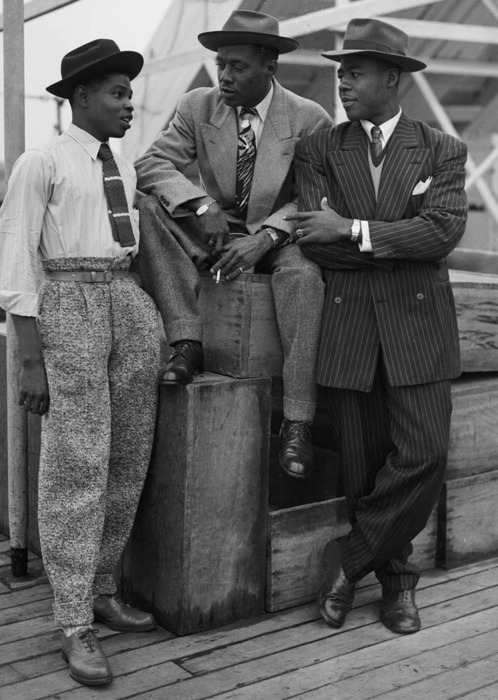
IWTV's costumes really embrace the high-waisted silhouettes of menswear in early/mid-20th century america, something that some historical dramas tone down to fit in with modern tastes. (21st century suit pants tend to be tighter and sit lower on the hips, aiming for a "swimmers build" aesthetic.)
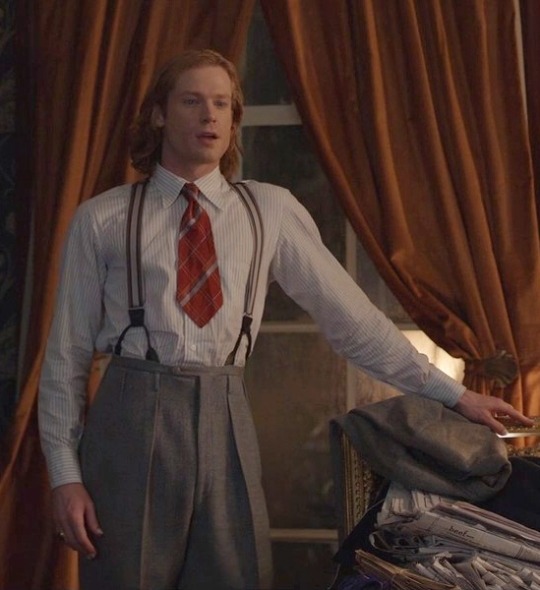

sam reid has the perfect figure for 1930s/40s fashion: a narrow waist and wide shoulders. pleated suit trousers have extra fabric around the hips/ass and are cinched in at the natural waist, which a) is comfortable and b) makes the waist look narrower, creating an almost hourglass shape depending on the cut. to modern eyes it can look more feminine than contemporary men's suits, which plays into lestat's Whole Deal.
one pair of lestat's drop-loop trousers (i wish i could find a better pic!) create even MORE emphasis on the waist by leaving a cummerbund-like waistband of fabric above the belt. it's the kind of finicky tailoring detail that makes it obvious that lestat is a real clotheshorse. he and louis clearly spend a ton of money on tailoring.
i also suspect that lestat's american wardrobe was influenced by the fact that he socialized with and lived alongside black people in the new orleans jazz scene. the most exaggerated styles of drop-loop trousers are something i'd associate with Zoot Suits, which were not a white/anglo style and would presumably have been worn by young black men in early 1940s new orleans. (in ep 1, louis is extremely fashionable and accessorized to the hilt, whereas lestat looks like he's wearing a historical costume.)
on a final note, i love that louis continues to wear high-waisted trousers in the present day. his modern outfits are quite soft, vulnerable and minimalist - close to the kind of simple-but-expensive clothes we'd expect to see on one of the cooler young tech billionaires, but with a silhouette that calls back to his youth.

4K notes
·
View notes
Text
It's Time for Samhain! (Oct 31- Nov 1)
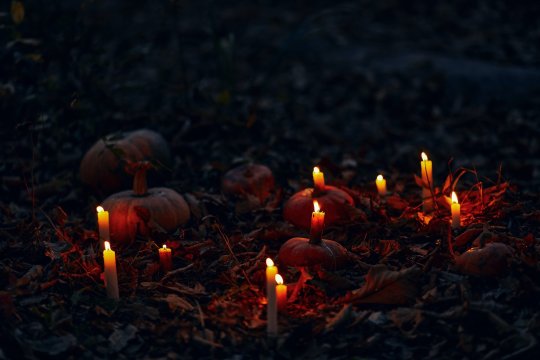
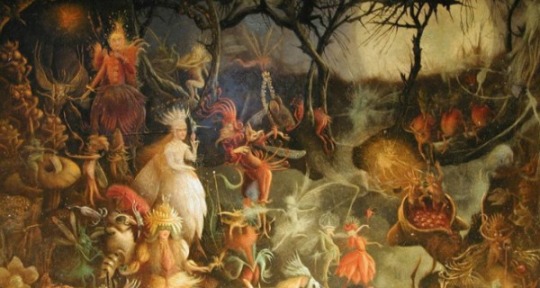
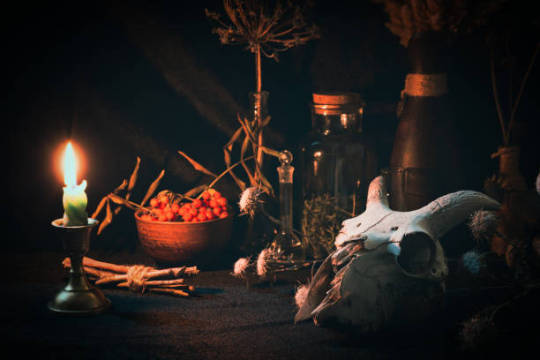
What is Samhain? In the Celtic calendar, Samhain marks the end of summer and the harvest season, and the beginning of the dark, cold winter months. It falls opposite Beltane on May 1, which represents the beginning of spring and the life-filled growing season.
It’s believed that the veil between the living and the dead is thinnest on Samhain. Historically, people were worried that they would encounter ornery spirits if they ventured outside on Samhain night, so they dressed as ghosts or wore masks to disguise themselves. Folks would leave treats on their front porch or place an extra setting at the table to welcome any friendly spirits who stopped by. You can see how these Samhain rituals easily morphed into our modern-day version of trick-or-treating in costume.
Nighttime bonfires were another of the long-standing Samhain rituals - this one was thought to help combat the impending darkness of winter and the fearful chill that accompanied the idea of roaming spirits. Because the veil between living and dead is believed to be the thinnest on this night, Samhain is also a powerful night for divination and spellcasting by candlelight.
Usual Symbols of Samhain:
Ale or Mead
Pumpkins
Skulls
Besom or Broom
Beans
Cauldron
Bats
Keys
Squash
Pomegranate
Nuts
Apples and Cider
Bones
Herbs and Plants for Samhain:
Rosemary – Associated with remembrance and is needed during this season in taking time to honor the memories of our ancestors and other lost loved ones. Can be used in an incense blend and at ancestor altar
Fall Flowers – Includes flowers like marigolds and chrysanthemums. Are associated with protection and chrysanthemums come in handy with connecting to the spirit world
Apples (the fruit, branches and blossoms) – Is considered sacred to a lot of gods. A good apple harvest means that the gods have shown the community their favor. You can use apples in different rituals, especially divination
Pomegranates – Is associated with the realm of the underworld and helps with communication with the dead. It is also associated with fertility of the fall.
Squashes, Pumpkins and Gourds – Is associated with abundance and provides sustenance for your family when the fields become bare and covered in snow. Is linked to psychic awareness and development and protection.
Mugwort – Is associated with divination and dreaming. Using Mugwort baths or incenses in the rituals can focus on treating depression, especially with the seasons changing
Rowan Trees – The branches and berries are a way to keep evil spirits out of your house and are associated with good health. If you plant a tree near a grave, it will prevent the dead from rising.
Sage – Is associated with cleansing and grounding. Is a great incense to cleanse your home to bring in the new and out with the old
Hawthorn – Has been associated with the gateway between humans and the spirit world. Is also rumored to an area where you can see fairies.
Crystals for Samhain:
Amethyst – Aids in opening one’s third eye and is valuable to be able to see Samhain’s spirits around
Black Obsidian – Is great for grounding and protect from evil spirits. Can be used in scrying when speaking to deities and spirits of Samhain
Citrine – Is used to honor the sun. Aids in prosperity spells and carries joy
Black Tourmaline – Wards off unwanted spirits from your property and can be buried into the ground to protect from psychic attacks and spirit intrusion
Orange Calcite – Orange is a sacred color to Samhain. This stone is associated with one’s sacral chakra and can cleanse and align reproductive organs, sexuality and get creativity flowing
Bloodstone – Known to heal cardiovascular illness and disease. Can help with ancestry links and work
Spirit Quartz – Is great in helping communicate with the spirits of Samhain and releasing old and toxic habits
Lepidolite – Used to appease the fairies that roam during Samhain
Serpentine – Is associated with snakes and aids in remembering past lives. Loki seems to like this stone and may be great to use for him if you work with him during this season
Dragonstone – Dragons are guardians of the earth, spirits of place, and connect us to Mother Nature. Helps say goodbye to the old years and our old selves
Skull shaped Stones – Since skulls are symbols of Samhain, skull shaped stone can help with symbolism during this holiday. They represent the life-death-rebirth cycle, wisdom and our ancestors
Spells and Rituals:
A Samhain Tea (Apple and Hawthorn Berry)
1 apple, sliced
2 Tablespoon dried hawthorn berries (or 4 Tablespoons fresh)
1 cinnamon stick
A pinch of cloves
4 cups water
Honey, to taste (optional)
Combine all ingredients in a small stockpot.
Bring to a boil, then reduce heat and simmer, covered, for 10 minutes.
Strain the plant material from the tea, then transfer the tea into two mugs.
Enjoy one for yourself, and leave the other on your table or front porch to nourish any wandering spirits who may pass while the veil between the living and the dead is thinnest.
A Pumpkin Spell for Prosperity
A pumpkin
Some paint
Go to the pumpkin patch (or local store) and select a pumpkin. Or let the pumpkin choose you.
Bring it home and paint prosperity symbols on it – money signs, runes for prosperity or harvest glyphs (whatever means prosperity to you).
Then place by your front door to invite prosperous vibes into your home this Samhain season.
Bonfire Release Purification Spell
Paper
Pen
Source of fire (bonfire, fireplace, candle flame)
Gather your materials and sit by the fire.
Take a few minutes to just listen to the fire crackling.
Gaze into the flames and connect with this powerful element.
Next begin to think about what habit or person you are releasing this Samhain. Think about why you’re purifying your life from this thing or person.
Then write the habit or person down on the piece of paper.
Fold it away from you 3 times.
Hold it in your hands and allow all of the negative thoughts and energies inside of you to “drain” out of you and into the paper.
Then throw it in the fire and say,
“After this Samhain, never again. Never again. I release _________ from my life by the power of the Samhain fire. So, mote it be.”
How to Make a Samhain Altar
Beautiful autumn leaves or flowers that you collect on a nature walk
A candle
A mugwort bundle
A string of rowan beads
A bowl of apples or a small pumpkin
A hawthorn wand or bowl of freshly picked hawthorn berries
A picture of your ancestors
To make an altar, first find a corner of your home or a table surface where you can arrange a few treasures. You don’t need a ton of space. You could use the top of a dresser, the corner of your desk, an unused side table, etc.
After you’ve assembled your altar, spend some time sitting quietly in the space. Light the candle and/or mugwort wand, sip on a cup of Apple & Hawthorn Berry Tea and meditate on this energetically powerful day.
I could find specific written instructions for a crystal grid but I found a video!
Crystal Grid for Samhain
Let's get ready for Samhain and have a great and safe time!
#witchblr#witch community#witchcraft#occultism#paganblr#green witch#nature#plants and herbs#herbalist#witchcraft 101#samhain#all hallows eve#halloween aesthetic#pagan witch#crystal witch#crystal grid#crystals#witches of tumblr#witches#spooky#pumpkin#kitchen witch#witch#witchy vibes#halloween#happy halloweeeeeeen
539 notes
·
View notes
Text
Can’t remember where I’ve seen the idea first but I’ve had this idea of Regular Clowns taking offense to joker’s bullshit for a while now and exacting Vengeance. The man doesn’t even has an egg! His ass never been to clown school! He’s a disgrace to them all!
So four buddies leaving the traveling circus business decide as people who have loved every second of this and are Deeply Insulted by this wanker to Do Something About It.
Three of them are showmen- an acrobat, a juggler, a fire fanatic, the works.
The last one, Jerry, is a stage hand. He is their most powerful member- not only does he have the superpower of self care, but he’s a meta! Minor telekinesis is actually really useful when shuttling stuff around in a stage in a hurry! (And that whole thing of our idea of ninjas coming from stage hands in all black being ‘invisible’ yeah. Cryptid vibes, except it’s just Jerry)
So. A clown car pulls up in Gotham, in the middle of a Joker attack, presumably despite ever Gothamite on the road who saw it making their best effort to take one for the team and mow them down. This is a no good awful sign for Gotham.
But it gets better.
Because out does not step a bunch of goon reinforcements in masks, or some jokerified poor soul, but instead someone in one of those historical jester costumes, bells and dramatic ass sleeves and all. Also, they’re bright orange. It is slightly eye searing. In one hand is the end to a long line of tied together handkerchiefs in clashing neon colors which appears to be infinite bc it just keeps coming. In the other is a comedically oversized hammer with a squeaky sound effect installed but no spring to soften the blow- it in fact has spikes with little Mayfair banners hanging off.
They immediately attempt to strangle/bash Joker to death with a winning smile firmly in place, and actually survive the attempt of which by apparent virtue of being made of rubber or something. And out slides our fire master, in all teal for contrast, who promptly throws smoke bombs at the crowd of goons around and starts all but boa staffing them down with his fire wand, paired with a dramatic speech about how Joker is in insult to the idea of circus and also the most unfunny bitch to ever walk the earth.
Lastly, the juggler. They have come armed. With glitter and hackysacks. A dramatic beatdown ensues, with much shrieking and yelling on all sides. A gif is made of Joker being bonked right through a concrete wall with a move right out of a video game. Several goons get concussions a la bowling pins. It’s all being live streamed by someone through their apartment window and is rapidly going viral. It’s a good time mostly because this attempt at vengeance against the Clown Bitch Gotham did not immediately involve some one getting very anticlimacticly shot.
No really takes note of the guy in all black and ski mask, calmly standing in the middle of the flaming chaos. He occasionally holds out a new set of props for the juggler, an oversized great sword for our acrobat jester, some nitroglycerin for blowy uppy efforts, the works. Until he starts calmly putting together a three story set of scaffolding for the gang to use for the purpose of beating the crime king’s skull in in even more ridiculous ways and also so jester can showcase their absolute lack of a spine.
And Jerry goes back to standing in the middle of this chaos, apparently unaffected by Literally Everything going on. His friends are fucking crazy, he’s used to it.
Meanwhile, Ghost King Danny gets a new urgent appeal at his ghostly royal desk- someone is attempting to enact vengeance against the joker and move approximately 46363883 souls along doing it, except it’s not the Red Hood this time! It’s Some Random Guys that a minor mischief god is now attempting to fast track layering with blessings! Said minor god is officially appealing for the Ghost Monarch’s support. Danny is conflicted- on one hand, he Fucking Hates Clowns. And has a major hero worship thing going on for Red Hood, a fellow supernatural hero (in the dead’s eyes) much his senior. However, the idea of a bunch of nobody’s beating the joker to death at the same time as declaring how shit of a clown he is IS pretty hilarious.
He gives it the stamp of Yes, provided others seeking vengeance (aka red hood, the thousands of joker victims in Gotham, anyone who wants to go spectacular viral) can still intervene to catch some own hands, a minor merriment/will of the people god does a jig on the spot, and back with the Justice Circus Brigade, ghouls and Spectors alike start popping up to join in on the fun! Which our beloved ren faire rejects are actually pretty okay with- big enough circus events in the DC universe have a bad habit of becoming possessed/very obviously haunted/Ooky Spooky like, every few months. And these guys look much friendlier than whatever the hell has been in the house of mirrors these last few months!
Red Hood isn’t sure how he’s suddenly in the middle of upper Gotham when he’s was decidedly Nowhere Near three seconds ago, but that’s a problem for later when the Bitch Ass Clown Extraordinaire is Right There!! So he tables it to be very paranoid about later, shrugs, and starts shooting. Jester starts shouting out points for accuracy/comedy, Jerry calmly asks if he wants some of their backup silver bullets just in case The Target really is an unholy being of some sort. (They have taken Precautions. For Everythinf. Or at least Jerry did.) Jason can’t say no to free extra ammunition and also That’s Hilarious, man he has to hire these guys!
Then fire juggler molotov’s the joker, and he decides these idiots are ABSOLUTELY worth saving from the big bad bat. Fuck it, this morons are the BEST.
#dc x dp#dp x dc#also can anyone find me that one fic where like the gang plus vlad dimension hop#and end up putting themselves in clone bodies in an abandoned Cadmus base#and superboy discovers them and the Wayne’s panik#pls I have such ideas for art of these nerds but no artistic ability#prety colors#the joker: I will kill u#a jacked acrobat juiced up acrobat powered by god and anime: I declare thee stupid. Bonk#a failed college dropout disaster twenty something: dISGRACE UPON YOU#ON YOUR COW#etc#and then there Jerry
211 notes
·
View notes
Text
The Historical Accuracy of Kirsten's Dirndl
Despite its adorableness, I have seen many people complain about Kirsten's Swedish Dirndl outfit.

I would kill a man to have bought this for $22.
She wears this outfit for most of Meet Kirsten, being that she is an impoverished immigrant child who does not own any other clothes, and also for continuity reasons.
Frequently, I have seen it claimed that this outfit is not historically accurate and should not have been included as part of her collection. Conversely, I have also seen many German folk costumes marketed as being made for Kirsten. Both of these pain me a great deal (actually they just annoy me).
Nonetheless, I have decided to further procrastinate doing actual, meaningful work and instead set out on a new mission: figure out what the fuck is up with Kirsten's Dirndl.
In this post, I will lay out the research I have done, the evidence supporting the historical accuracy of this outfit, the challenges to its existence, and ultimately aim to answer the question of whether this outfit is one Kirsten plausibly could have worn on her journey from Sweden to America in 1854.
Let's begin.
First, the name. Pleasant Company/American Girl referred to this outfit as "Kirsten's Swedish Dirndl and Kerchief."
Unfortunately, there is no such thing as a Swedish dirndl. "Dirndl" is a German term, and refers to folk costumes worn by people in German-speaking areas of Europe (the Alps, Bavaria, Austria, and so on).
Kirsten is Swedish, and before Meet Kirsten has never left Sweden before. It is very unlikely she would have acquired, and regularly worn, a German dirndl. See this gorgeous example of a dirndl c. 1840:

Outfit, c. 1840. Munich, Bavaria, Germany. Münchner Stadtmuseum.
This ensemble is beautiful, but tragically, it is not what Kirsten is wearing.
What, then, is Kirsten wearing? What kind of traditional dress does Swedish culture have?
As it turns out, the proper term for what she is wearing is a folkdräkt. This is a Swedish term meaning "folk costume." Here is an illustration depicting multiple examples of Swedish folk costumes. In proper terms, these would be called "Svenska folkdräkter."

Nordisk familjebok (1908), vol. 8, Folkdräkt. Retrieved from runeberg.org.
These outfits are not quite identical to anything we see in Kirsten's collection, but you can observe various elements that have carried over -- the vertical stripes, black woolen skirts with ornate trim, and white dresses and red sashes (hello St. Lucia)!
Let us dive deeper. What do extant Svenska folkdräkter, specially those made c. 1850, look like? Is there anything like Kirsten's outfit among surviving examples?

Johan Sodermark, "Kvinna i dräkt."
In my few hours of research, this example image is the closest thing I have found to Kirsten's dirndl.
This lovely portrait is a watercolor from 1850 painted by Johan Sodermark. It is very creatively titled "Kvinna i dräkt" -- literally, "Woman in costume." The pattern of this woman's apron is incredibly similar to that of the skirt of the Kirsten doll's outfit -- a dark red base with blue and yellow stripes woven throughout.
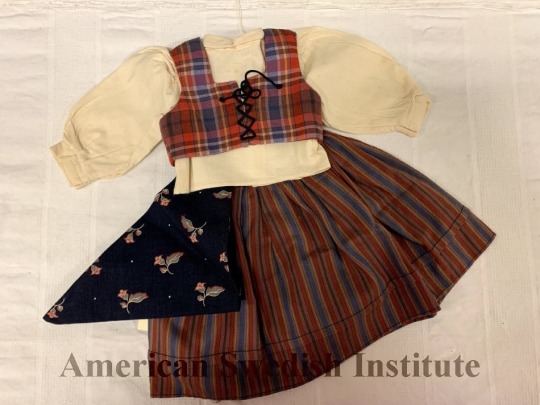
Here is a closeup from the American Swedish Institute.
Although it is not shown in the doll-sized version of the outfit, the illustrations in Meet Kirsten by Renée Graef show us she also wears a light-colored, striped apron, which is almost surely the one that comes with her meet outfit.
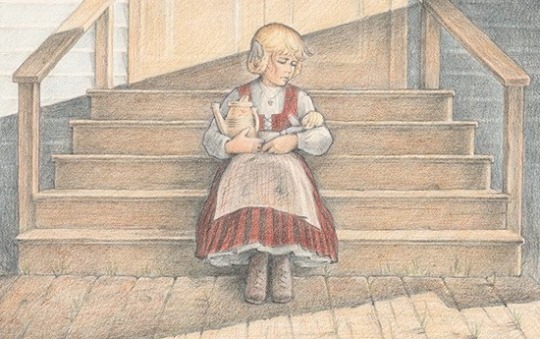
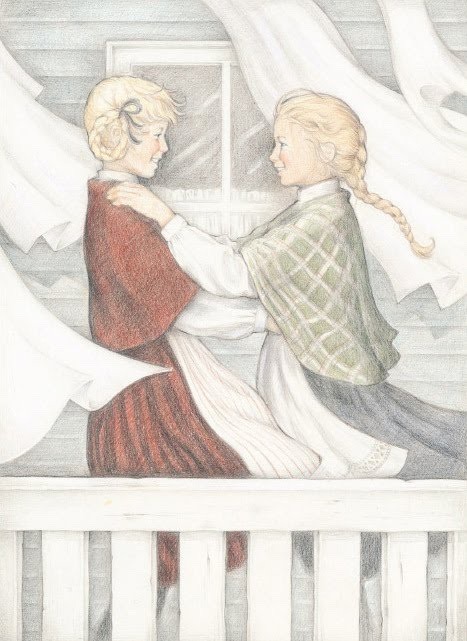
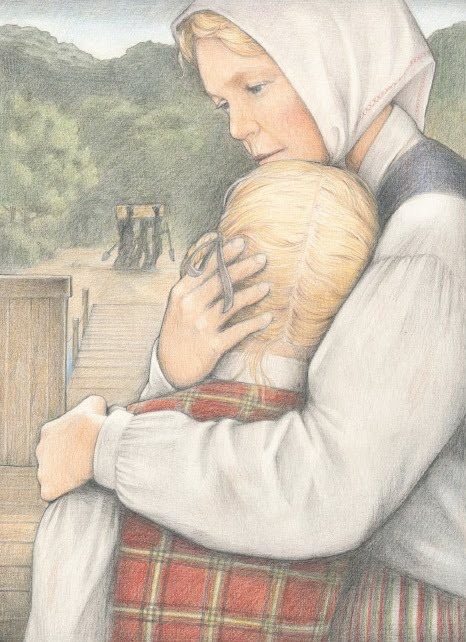
Illustrations from Meet Kirsten, drawn by Renée Graef.
Notice the fabric of the bodice in the third illustration, though: Kirsten's top is made of red plaid fabric, while Sodermark's girl has an outfit full of stripes. Kirsten, bless her heart, spends an entire book outfit-repeating a potential pattern-mixing fail: plaid and two kinds of stripes and a floral scarf. Did Pleasant Rowland just hate her? Is Kirsten on another, elevated fashion plane far beyond my comprehension? Is there a historical basis for this combination of patterns?
I have no answer to the first two questions, but thankfully can speak on the third.

Komplett Vilskedräkt, Västergötlands museum. Some pieces c. 1865.
The top is plaid and laces up, which is not necessarily the most common way of fastening (in most examples, the bodice pins up), but it is a sensible choice considering both Kirsten's age (9) and the fact that Pleasant Company was making toys for little hands.
The model for the outer shell (the lace up top) belonged to Karl Edberg from Hällestad; it is not dated, but at least one piece of this set (the bag, which is not shown) is c. 1865. Additionally, the blouse here is very similar to the one that comes with Kirsten's winter outfit -- look at that keyhole neckline!

So, Kirsten's Dirndl outfit is actually very accurate as far as the clothing itself goes...the name remains the trouble.
I have no idea why they called it a dirndl. Folkdräkt is definitely challenging to pronounce, but why wouldn't PC just translate it as "folk dress" or "Swedish outfit" and call it a day? Why the insistence on referencing a culture that isn't relevant to the doll or her dress at all?
Perhaps this is a mystery to tackle for another day...
#kirsten larson#kirsten#american girl#pleasant company#meet kirsten#american girl kirsten#american girl dolls#agig#ag doll#ag dolls#american girl history#historical characters#1854#rambles#kirsten 1854#historical clothing#historical fashion#american girl analysis#renee graef#swedish historical fashion#folk dress#pleasant rowland#ag tumblr#ag on tumblr#american girl doll tumblr
343 notes
·
View notes
Text

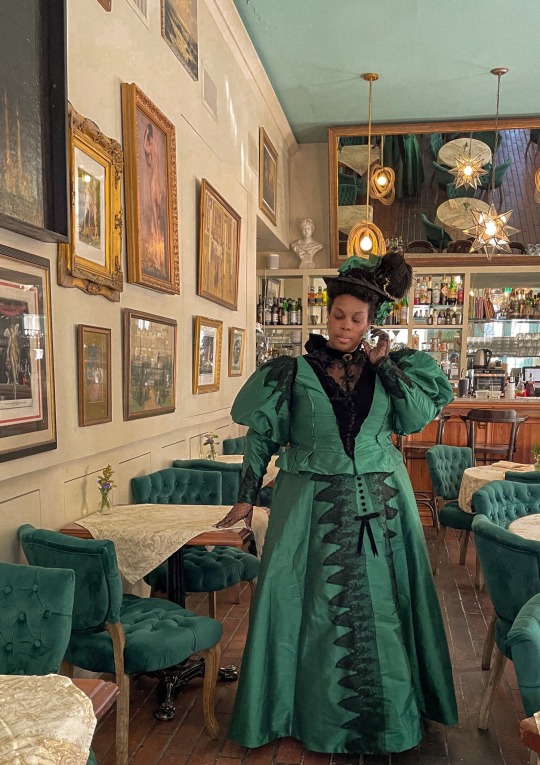
Belle époque mood in Café Amelie of New Orleans || IG
#antique aesthetic#poc dark academia#antique academia#historical costuming#historical costume#black people in period clothing#black people in historical costume#1890s#1890s dress#late victorian fashion#late Victorian#victorian aesthetic#mignonne#2023#green#walking suit
2K notes
·
View notes
Text
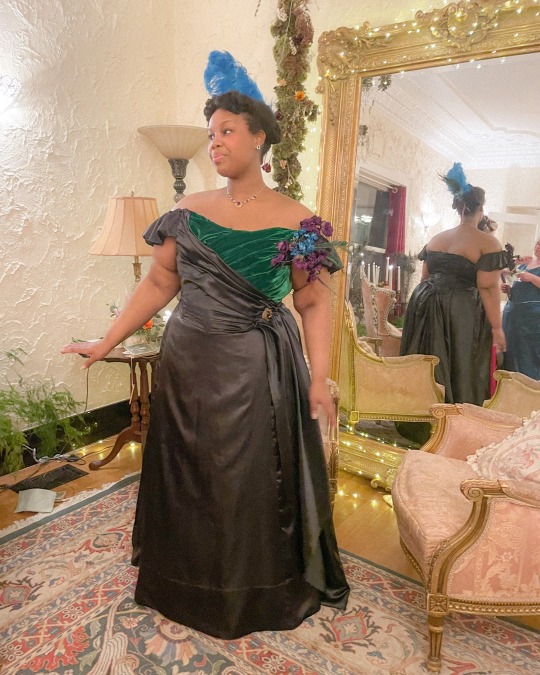
posting this black gown on my pink main because everyone needs to see this photo of me at the ball. sans gloves, quelle scandale !
#historical fashion#historical costume#fairytale aesthetic#princesscore#black people in period costume#black people in historical costume#Victorian#late victorian fashion#late victorian era#turn of the century#mignonne#2023#light academia
2K notes
·
View notes
Text

If anyone knows a thing or two about sex scenes, it’s Sam Heughan. Over the past decade, the 43-year-old Scottish star of Outlander, the cult-hit historical drama, has filmed hours of notoriously raunchy footage in his role as Jamie Fraser, the dashing 18th-century Highland rebel, with his wife, Claire – a time-traveller from the 20th century, played by Caitríona Balfe.
Yet two years ago, Heughan, as one of the executive producers (with Balfe), introduced an intimacy co-ordinator to choreograph such scenes, which had been criticised by many as excessively violent.
“The industry’s completely changed since Outlander started,” Heughan says, sitting in a Soho bar on a visit to London from his home outside Glasgow. “Not just our show but also shows like Game of Thrones were very graphic, with no room for the imagination, in a way that’s quite jarring now. As young, keen actors, we were just expected to get naked and go at it. Caitríona and I formed a bond and trusted each other, but there were times when we were pushed too far.” He was especially troubled by a scene involving full-frontal nudity in season one, when Jamie was tortured and raped by his rival, Black Jack Randall (Tobias Menzies). “That really didn’t sit well.”
Everything changed following the MeToo scandal, leading Heughan to employ Vanessa Coffey to choreograph the sex scenes. “So now everyone knows what the boundaries are, like in a football or rugby match. It’s been so helpful and freeing, and it was because I didn’t want younger actors to go through what we’d gone through. Now, the scenes are sexually charged, but not gratuitous.”
Despite his heartthrob status, Heughan – who’s 6ft 2in, with the strapping physique his role necessitates – is modest and thoughtful company. He also had Coffey enlisted to co-ordinate his latest project, Channel 4’s erotic thriller The Couple Next Door, filmed during the short break between Outlander’s seasons nine and 10, in which he plays Danny, a policeman living in a Leeds suburb in an open marriage with Becka (Jessica De Gouw).
“We didn’t want to make a salacious or seedy show about swingers,” Heughan says. “It’s about the psychology behind it – what is it to be in an open relationship where two characters love each other so much that they can invite people into that relationship? I think it’s possibly the greatest form of romance to allow your partner this, if it’s the itch they need to scratch. My character struggles with it.
The couple’s (initially) strait-laced neighbours are played by Alfred Enoch and Eleanor Tomlinson, who in 2019 finished five seasons as Demelza in Poldark. With Outlander about to start filming its final season, she and Heughan compared notes on moving on from a huge, long-running costume drama.
“It’s emotional. For me, the prospect’s hugely bittersweet. It feels like getting out of an institution. Outlander’s like a family, it literally defines who I am.” After all, Heughan has created an empire of Outlander spin-offs, including books, television travelogues and his spirits brand, The Sassenach – named after Jamie’s nickname for the English Claire – not to mention his charity, My Peak Challenge, which has raised nearly £5 million to fund a variety of causes, including hunger relief and blood-cancer research. “I’m ready for new challenges, but also nervous about what it’s like in the real world,” he says.
Still, he felt now was the right time to wrap. “Outlander could have finished after the ninth season, but, personally, I felt we hadn’t quite got there. So now we have the problem of pushing the writers to do something that’s hopefully satisfying for the audience, but also exciting.” So Heughan doesn’t yet know how Outlander ends? “No idea, and it’s really tough because Diana [Gabaldon, the author on whose novels the series is based] has written so many books.”
The show has a vast international fanbase; VisitScotland has cited a 67 per cent rise in visits to the show’s locations, such as Culloden and Inverness. “I do feel like I’m an unofficial ambassador for Scotland, and sometimes I don’t think the show is given enough credit for what it’s done for Scottish tourism,” Heughan says. “I think the numbers are even bigger than they say, because reams of Americans are just making their own itineraries. Doune Castle’s numbers are up 800 per cent, it’s been completely renovated as a result.”
The show has also transformed the local film industry. “For 10 years, we’ve been employing people at over 200 Scottish locations, we’ve started an intern scheme, we’ve built a studio with five sound stages where there was nothing before. So it’s going to leave a legacy.”
The son of an artist single mother (his father walked out when he was a baby), Heughan spent his early childhood in the Borders, his teens in Edinburgh, before studying at Glasgow’s Royal Scottish Academy of Music and Drama, where his mentor was third-year student James McAvoy.
Having worked in London and Los Angeles, Heughan fell back in love with Scotland when he was cast in Outlander. Initially against independence, filming the first season in the run-up to the 2016 referendum transformed him into a vocal advocate. “Scottish politics right now is a bit of a mess, which is a shame, but maybe they’ll find a new rallying cry. We’re a great wee country with amazing resources, most of which are controlled by the British. Similar small European countries have great identities.”
Initially, Heughan is hesitant to discuss the issue, aware taking either side will provoke a social-media backlash, but then he decides: “Why can’t actors have opinions? The problem is you have to come down on one side, there is no room for debate. Everything has become so aggressive and then social-media algorithms mean you only get to see one side of the argument.”
He had his fingers burnt when last month he signed an open letter from Artists for Palestine UK, alongside the likes of Tilda Swinton and Steve Coogan, which accused the Government of “aiding and abetting” Israeli war crimes, but failed to condemn Hamas’s terrorism. The following day, Heughan rescinded, saying he hadn’t “fully understood” what he was signing.
“I was maybe naively calling for peace, which is what we all want, but, unfortunately, that situation is so complex, I can’t understand it all,” he says now. “As an actor, you have a platform, but if you put your thoughts out there, you upset people, but you’re also damned if you don’t say anything.”
Heughan’s taking time to navigate a potential post-Outlander career path. “I’m a workaholic, but I have to be discerning. Whatever I do next, I have to feel really passionate about.” Possible plans include directing and exploring a different side to Scotland than misty heather and bagpipes. “I think that underbelly you see in [Ian Rankin’s] Rebus and Irvine Welsh is very interesting, there are still pockets that are very hard and gritty.”
Back in 2005, he auditioned for James Bond in Casino Royale – the role that eventually went to Daniel Craig. Now, there’s a new vacancy. “I’ll throw my hat in the ring,” he says, grinning. “I’d be a brilliant Bond, I’m good at action and I’d bring a lot of emotional intelligence.”
There might even be space for a personal life. Heughan’s mystified by “facts” he reads about his private life online. “There’s so much nonsense that’s completely false – apparently, I have a daughter. News to me!” he says, flushing. The truth, he says, is that Outlander leaves no time for relationships.
“It’s insane hours and takes over everything. Caitríona’s carved out a beautiful family for herself that she protects very well, but I’ve seen how hard it is for her to do that. I want a cat, but I’m too scared even for that, how would I look after it? One day, maybe,” Heughan says, dreamily.
Posting again as some people had difficulty opening the previous link.
138 notes
·
View notes
Text
Thanks for tagging me @little-desi-historian! ❤️
YES, all of this takes me back to something I wanted to touch a lot more on in my original post when it comes to the historical male image, Percy, Lestat, and Matadors; because it truly does link back to how AMC is playing with dandyism and society's expectations about effeminate men.
Dandyism is a form of resistance culture. As I've said before, Lestat flouts gender norms because HE CAN do whatever he wants & get away with it. His androgyny's on a different level: effeminate or masculine, he's still a vampire, a SUPERnatural creature elevated beyond the bounds of social mores that determine what men & women could or SHOULD act/dress like. MANY people across social media have pointed to Lestat's limp wrists, long blonde "Barbie" hair and ESPECIALLY him dressing in drag in Ep7 as proof that he's the "wife/mother/woman/femme fatale" in Lousta's relationship, and THEN claim its either gender essentialism or homophobic/racist to say Louis is CANONICALLY female-coded one in BOTH the books and show (as AR said so). But no, Lestat in drag was a power move, because he doesn't care what anyone thinks/says/does--he'll just eat them. Mockingly eating the baby in a dress was a deliberate bastardization of motherhood/womanhood. Louis is called every homophobic name in the book by those expecting the black man to just take being insulted, but MARQUIS de Lioncourt DEMANDS being crowned KING of Mardi Gras, Krewe of Raj, & he'll show you exactly what he thinks about your silly homophobic hypocritical human society: You're just "the MEAT," let them eat KING Cake--you're his FOOD. Eff y'all, I'm dressed to KILL you, & laugh doing it.
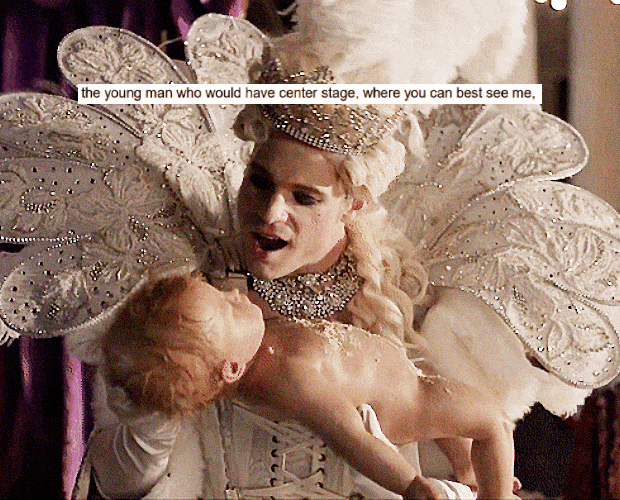
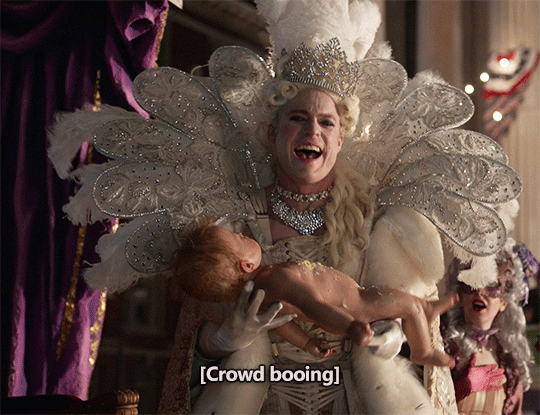
Lestat's behavior is not only derived from the time period he was born & raised in (the Rococo era of so-called "effeminate" high class dandies--a la Percy Blakeney, etc). Lestat is the embodiment of PRIVILEGE: a powerful rich white male vampire, who leans into being foreign/French White to excuse anything he does that people find strange/off/unnatural/dangerous--all the red flags. 🚩🚩🚩
And red flags brings me directly back to matadors/toreros.

@toscrollperchancetomeme
😂 TYSM! Sam Reid dropped so many juicy deets; I couldn't resist! There's so much depth to the Matador outfit, beyond the gendered aspect of bullfighting that I discussed before. Let's go back to what Sam said about Lestat, and delve deeper into matadors:


The most iconic apparel worn by toreros ("bullfighters") / matador de toros ("killer of bulls") in Spanish bullfighting is the Traje de Luces, the "Suit of Lights." The colors are usually bright & vivid, as part of the showmanship & pizzazz. Darker palettes are less common, as shiny sequins (the luces/lights) became part of the standard fit.


However, Lestat's all-black Matador outfit from what Sam called the "villain sequence" in Ep5 seems to be loosely following the style of a different but very closely related outfit, the Traje Campero "Rural/Countryside Suit" aka Traje Corto ("Short Suit").
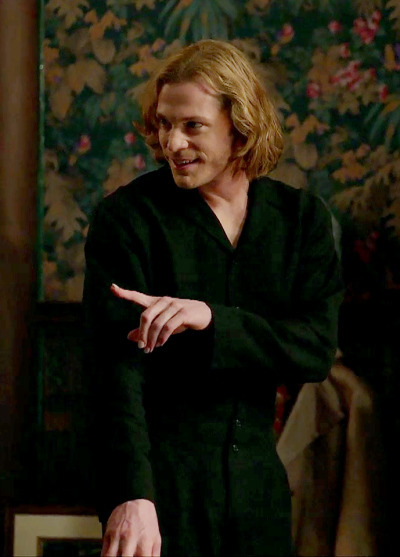
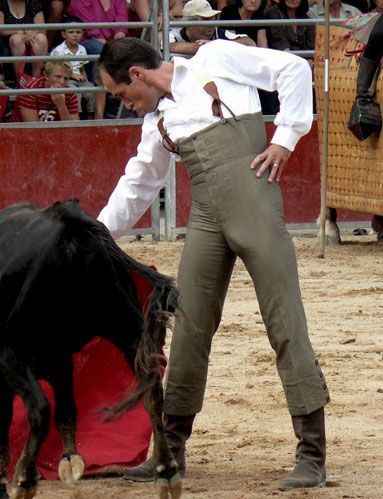
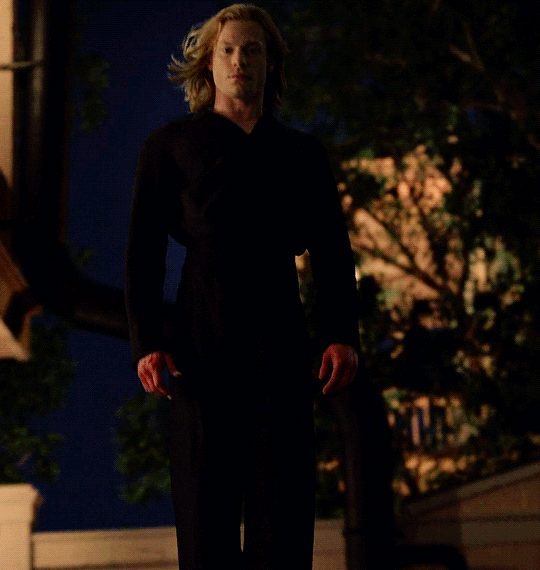
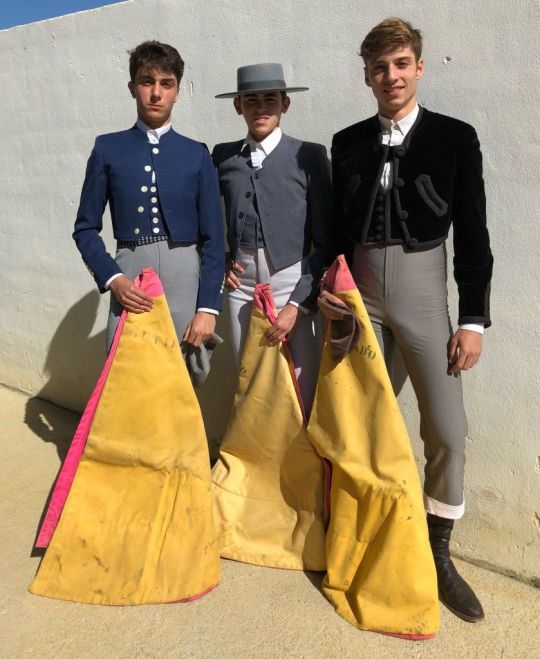
(These costumes are typically worn during ceremonial parades and a very specific festival I'll get back to in a moment, cuz it's important.) Unlike the Suit of Light's sequins & silk, the Rural Suit is made of suede, leather, or velvet, in dark muted colors. The pants can be light or dark, striped & patterned, with or without chaps (also found in gentleman's uniforms of military officers and cowboys).
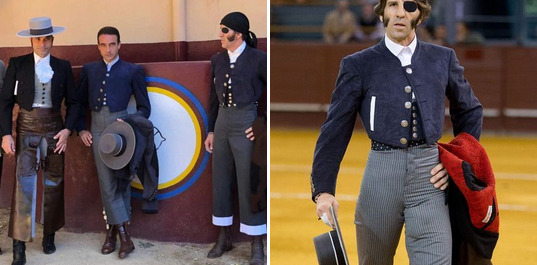
The trajes originated from "the flamboyant costumes of the 18th-century dandies and showmen involved in bullfighting, which later became exclusive to the bullfighting ritual." (Wikipedia)
The ancestor of both trajes (luces/campero) is traditional 17th-19th century Andalusian clothing (Andalusia being the home of Spanish bullfighting), closely associated with a very particular type of masculine dandyism. (The campero/corto is also the costume worn by Andalusian male flamenco dancers.)
"Before the 17th century the profession of bullfighting did not exist as such, and the fighters did not wear luxurious & shiny trajes de luces, but instead normal clothes of the time according to the social class to which the bullfighter belonged. The first bullfighter trajes de toreros appeared in the 17th century, when professional bullfighters from Navarre & Andalusia wore characteristic garments with their gangs to participate in performances and thus differentiate themselves from other bullfighter bands." (translated/truncated from Spanish website)
In the mid-1700s, Francisco Romero revolutionized professional bullfighting by establishing the first matadors who fought on foot, heroically fighting the bull face to face with swords & the muleta (iconic red flag) in a dance-like performance, dressed in a suede/velvet coleto (jacket), a precursor to the traje campero. Romero (from a carpenter family) wanted to show off & stand out from the nobility, and changed the game entirely, through a form of social resistance-turned-innovation.
"At that time, bullfighting on horseback was more important, which was considered a sport and not a show. Bullfighting on foot was not yet widely recognized." (translated from Spanish website)
Bull-killing on horseback was practiced by Spanish noblemen, attended by lower class assistants on foot. Romero was the first to make on-foot matadors the stars of what was increasingly becoming a dandified show/performance/dance. Matador Joaquin "Costillares" Rodríguez introduced even more showmanship, competing against Francisco Romero's grandson Pedro Romero (famously painted by Goya--bottom right).
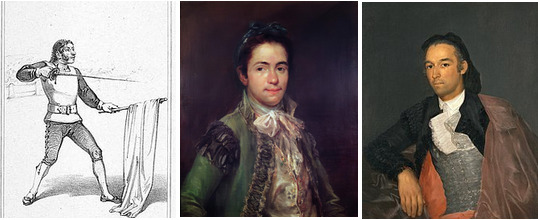
For his matches, Costillares (middle) dressed in flashy silks, threaded in shiny silver braiding; the precursor to modern traje de luces. Like Francisco Romero (left), Costillares wanted to show off & stand out; and revolutionized the male image of the bullfighter through clothes.
In 18th-19th century Andalusian Spain there were 2 types of dandy: the French-imported upperclass petimetre (effeminate dandy), and the indigenous working class majo (masculine/macho dandy).
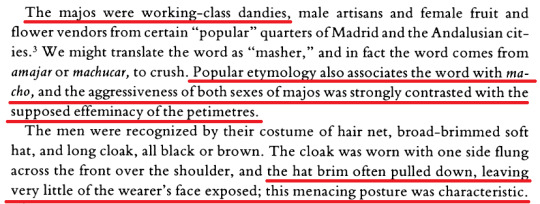
Noyes, Dorothy. “La Maja Vestida: Dress as Resistance to Enlightenment in Late-18th-Century Madrid.” The Journal of American Folklore 111, no. 440 (1998): 197–217. https://www.jstor.org/stable/541941
The majo, like many dandies, became the peak of Andalusian fashion, across all social classes; and torero/matador outfits weren't the only ones to take cues from them:


18th-19th century majos "distinguished themselves by their elaborate outfits and sense of style in dress and manners, as well as by their cheeky behavior. The majos outfits were exaggerations of traditional Spanish dress. The style stood in strong contrast to the French styles affected by many of the Spanish elite under the influence of the Enlightenment. Majos were known to pick fights with those they saw as afrancesados ("Frenchified" – fops)." (Wikipedia)
The majos' flamboyant/cheeky/saucy/exaggerated behavior was aggressively masculine; a lower/working class resistance to social mores imposed on them by (foreign) elites, whom they saw as more feminine, and FOUGHT against, to reaffirm their masculinity. These dandies were violent, brazen non-conformists; as beautiful & stylish as they were dangerous. And matadors/toreros knew that the bullfight was the perfect arena to exemplify the spirit of the majos through the dandified performance art/sport of killing bulls--a universal cultural symbol of masculine prowess & strength. Spanish bullfighting used to belong solely to the aristocratic equestrian sphere. Lowly pages/assistants like Francisco Romero (dressed in the precursor to the Rural/Countryside Suit), were the first to buck the system by killing bulls on foot--he likely didn't own a horse. The Romeros were from a carpenter family. Costillares was the son of a butcher. But through bullfighting they gained social status and became icons of masculinity--and dandies.
Lestat--the nouveau riche son of a poor country marquis--insists on being all the beautiful things he is without apology: masculine & effeminate alike. But like I said, it was no coincidence that Carol likened Lestat's Ep5 villain outfit with matadors--he's fighting Louis for dominance in their household, and reaffirming his place at the top of their very gendered social hierarchy, as a warning to BOTH "the housewife" AND "the prodigal daughter" he feels are threatening his authority as their Maker, so he defeats them BOTH.
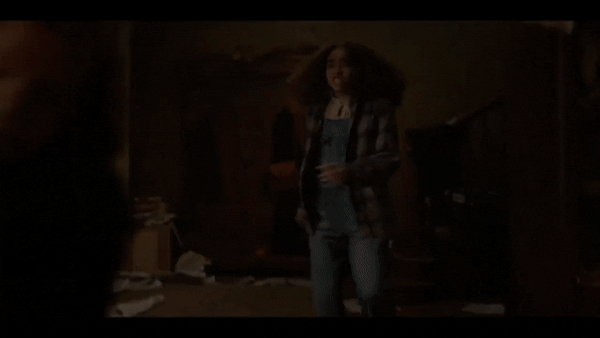
Carol Cutshall initially designed Lestat's matador pants as pajamas--loungewear. (Lestat's CASUAL & comfortable in his ability to KILL--matador means "Killer" in Spanish--and remember what I said about Louis & Claudia being put on the same parallel level in Ep5, when Claudia's attacked by "Killer" aka Bruce.) Sam said Carol made several versions of the pants; and yup, they're foreshadowed in Ep5 when Lestat first starts arguing about Louis' depression, then they pop up again in Ep7 during the Murder Plot--two instances @dwreader brilliantly linked Lestat (& Stanley Kowalski) wearing wifebeaters. (Listen, Carol, I just wanna talk.... 😅🔫)
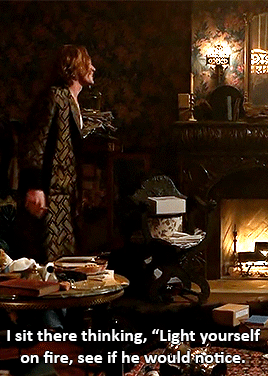

And here's my last points about Lestat's matador outfit. First there's the irony of Lestat (who grew up poor in rural France) wearing the something very similar to the matador/torero's Rural Suit, traje campero (aka Short Suit (traje corto)). But what's more interesting is that that type of Short/Rural Suit is usually only worn during special festivals called the Tienta ("trials"), not the regular corrida ("bullfights").

These Tienta are trials for young and immature bulls to be tested in the ring, to see if they're fit for breeding/fighting. 🤯 FLEDGLINGS. And who's Lestat's young bull? "Built-like-a-bird" Claudia. Who's the immature bull? The "biggest rat eater of them all," the under-developed "botched" vampire Louis. During these trials, veteran matadors can show off their skills; and novice bullfighters are shown the ropes and prove themselves. Like I said: the matador wins again.
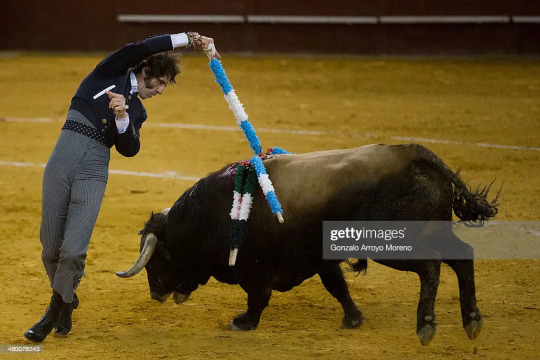
God, even the way Lestat dragged Louis' bloody body out of the courtyard by the jaw/neck resembles the way the defeated bull--bled out & stabbed in the neck--is dragged by the neck out of the ring.

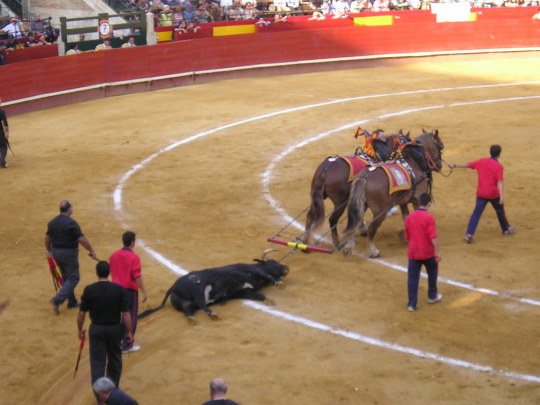
And remember what I said about Lestat and FOOD. Cuz what happens to the bulls after the matadors kill them? They're sent to the slaughterhouse to be butchered for FOOD. People EAT the bulls.


So yeah, my whole point in this post and my first one is not to sleep on guys like Lestat, Percy--or even other famous dandies like Valmont from Dangerous Liasions/Cruel Intentions (mentioned by both @little-desi-historian and @dwreader)--just because they're effeminate--especially when they're emulating mannerisms from a time period where the model of what made a fashionable gentlemen/good breeding/elite society did NOT match modern expectations about gender. People are getting distracted by Lestat's yaasified manner, not what the show itself is signalling through the relationships he has with others.
This show is deliberately painting Lestat as a villain through Louis' & Claudia's perspectives, as they were the ones who suffered under his Reign of Terror. The symbolism behind the matador-inspired costume used in Ep5 reflected gendered social hierarchies embedded within bullfighting culture (in Spain, women only started being allowed to fight in the 19th-20th centuries). Dressed in clothes resembling that of a matador, Lestat beating & defeating Louis mirrored the defeat of the emasculated bull, and the reification of the victor's masculine prowess at the top of the foodchain.
#the vampire lestat#lestat de lioncourt#male fashion#fashion history#gender inequality#read a dang history book#operation matador
351 notes
·
View notes
Text
SAG-AFTRA and WGA on the Line!

[Image ID: A tweet from J.W. Hendricks (@JW_hendricks) from July 14th that reads:
Let's fucking go. #SAGstrike #WGAStrong
Under that is a black and white image of a person in a hat, sunglasses, and a Writers Guild of America shirt holding a sign that says "Now We Have SAG HO HO HO"
/End ID]

[Image ID: A tweet from Brig Muñoz-Liebowitz (@brigliebs) from July 14th that reads:
Seriously excited to see our picket line chants performed by talented professionals who know how to project from the diaphragm. #wgastrong #SAGAFTRAstrong /End ID]
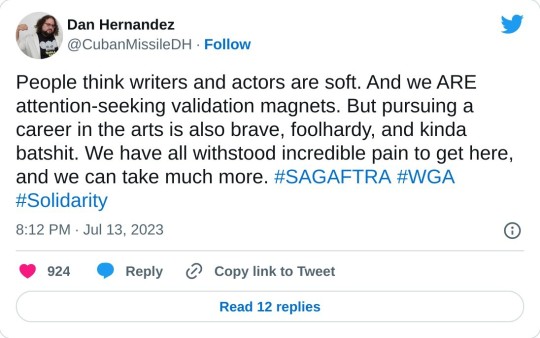
[Image ID: A tweet from Dan Hernandez (@/cubanmissileDH) from July 13th, 2023 that reads:
People think writers and actors are soft. And we ARE attention-seeking validation magnets. But pursuing a career in the arts is also brave, foolhardy, and kinda batshit. We have all withstood incredible pain to get here, and we can take much more. #SAGAFTRA #WGA #Solidarity
/End ID]

[Image ID: A tweet from form L&O SVU writer Robert Brooks Cohen (@RobertBCohen) that reads:
The much-anticipated WGA/SAG-AFTRA crossover has begun. ✊✊ #WGAStrong #SAGAFTRAstrong #DUNDUN
With a picture of him holding a sign that says in full:
In the studio entertainment system, viewers are represented by two separate yet equally important groups: the Writers Guild of America, who create entire worlds, and the Screen Actors Guild who bring them to life. These are their stories. DUN DUN. /End ID]
Granted, there's also everyone in production, the set designers, the costume designers, the hair and make up people, lighting, sound engineers, etc. But I get his point. Anywho, the image of him in full:

I'll try to ID this one:

(link to first post)
[Image ID: Three tweets from three different WGA members from July 14th, 2023 that read:
Travis Helwig (@travishelwig):
Actors are tall
Mike Royce (@/mikeroyce):
a guy whipped his shirt off at like 9:01 this morning, we're in a different reality now
Jackie (Decembly) Penn (a strike captain) (@JackiePenn18):
We had like 5 actors do that this morning. We were not ready for it 😂.

[Image ID: Tweet from Justine Bateman (@justinebatemanl from July 14th, 2023 that reads:
This is what you get when you give over 100k actors a call time.
@sagaftra @WGAEast @WGAWest #ShowingUp
With a picture of many, many people striking.
/end ID]
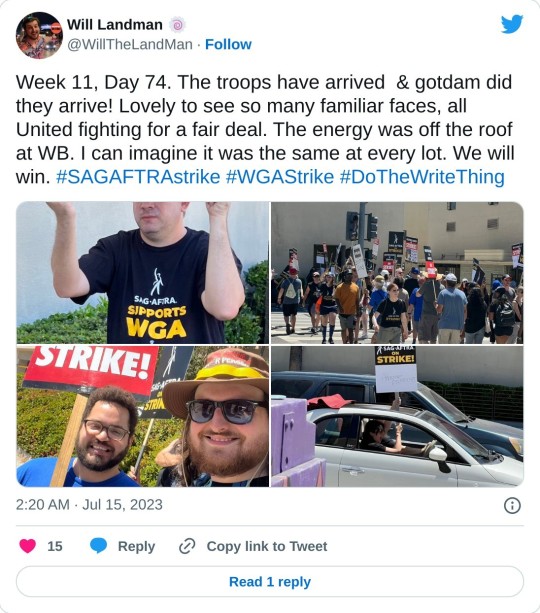
[Image ID: a tweet from Will Landman (@WillTheLandMan) from July 14th, 2023 that reads:
Week 11, Day 74. The troops have arrived & gotdam did they arrive! Lovely to see so many familiar faces, all United fighting for a fair deal. The energy was off the roof at WB. I can imagine it was the same at every lot. We will win. #SAGAFTRAstrike #WGAStrike #DoTheWriteThing
After that are four pictures for their day striking.
Also, I just want to say for historical record: today was WGA Strike Captains Day, though idk if that was just at the WB lot or not.

[Image ID: a tweet from actor Christopher Gorham (@ChrisGorham) from July 14th, 2023 that reads:
Day 1. Again. I was there for the beginning of the @wgawest strike so you know we were going to be there for @sagaftra . Enough people at Disney today to wrap around the entire studio’s 1 mile perimeter. Here’s to the unrealistic militant minority! #sagaftrastrong #wgastrong
The post contains four photos from his time striking. /end ID]
Bonus: WGA West showing up for Teamsters on the Amazon Picket line:

[Image ID: a tweet from Liz Alper (@LizApls) on July 14th that reads:
When @Teamsters call, @WGAWest responds.
We joined Teamsters on their picket line at the @/amazon warehouse in Santa Clarita. Amazon drivers deserve fair compensation and safe work conditions (and AC). We'll see you next time, Teamsters. Don't order from Amazon.
Four pictures are included in the tweet from the day showing multiple people holding WGAW signs. /End ID]
Honestly, all this solidarity during all the strikes this summer is bringing a tear to my eye. I love seeing everyone standing up for each other and fighting together. Union Solidarity.is.stronger.than ever, and it's beautiful to see.
#sag aftra strike#wga strike#double strike 2023#jw hendricks#brig muñoz liebowitz#dan hernandez#robert brooks cohen#travis helwig#mike royce#jackie penn#justine bateman#will landman#liz hsiao lan alper#liz alper
348 notes
·
View notes
Note
So I read the ask about historical fashion and I too love clothing and it got me thinking. Witchers are in my mind at least, both fairly minimalist and asteere, in large part due to their enhanced senses. But also very practical, as a function of, in many cases, life times on the road, with minimal time and resources to spend on anything frivolous.
(This is why the canon armour spikes drive me up the wall. Like the studs in the Netflix costumes make sense, they provide extra strength and tiny spots of extra protection, and are reasonably easy to repair. Spikes are not the same. You can hammer in a stud on any reasonably flat rock. To hammer in a spike you need a special heavy metal tool to hold it in place. And what do the spikes gain you? A tiny scratch, on a handful of monsters not covered in think hide or scales? No. No self respecting witcher is wearing spiked armour. I will die on this hill. Anyway...)
So, witchers, asteere and practical. What if, as the previous anon pointed out, with the new team patrols they start bringing back more monster parts to experiment with. And, they realise, oh wyrvn scales are like the next step up from chain mail. Hard and flexible but way lighter and slightly magicly resistant. And kikimora hide is basically natural oiled leather, you can wipe blood and guts off it with a cloth and they just slosh off. Plus the smoothness is pleasant on witcher sensitive skin.
I could go on and on. But they basically take all these parts and start outfitting themselves in them because they have practical applications. Then the nobels follow them, but without the background knowledge. So they pick the silly parts out, like eyeballs and teeth and who knows what, that have no practical purpose. So you can tell, subtly, who's truly and ally, by if their clothing understands the underlying properties of the monster parts or if they're just there for show.
On an unrelated note. I'm imagining how confusing it would be to try and copy the Kear Morhen royalty's 'fashion' when it consists of Gerald and Eskel, typical all black witchers, and Jaskier, bright, colourful, shiny birb. Truly, what does one do with such extreme options.
I love commentary like this; I have no background in fashion myself, and I adore having people who know more providing so much depth and breadth to the idea!
Witchers snickering at humans who have the Expensive rather than the Useful parts of monsters as accessories is a great mental image.
And yes, "Kaer Morhen fashion" is a little...uh...confusing to outsiders. Do you wear all black to honor the Warlord? Do you wear - uh - entire rainbows to imitate the Consort? Help!
54 notes
·
View notes